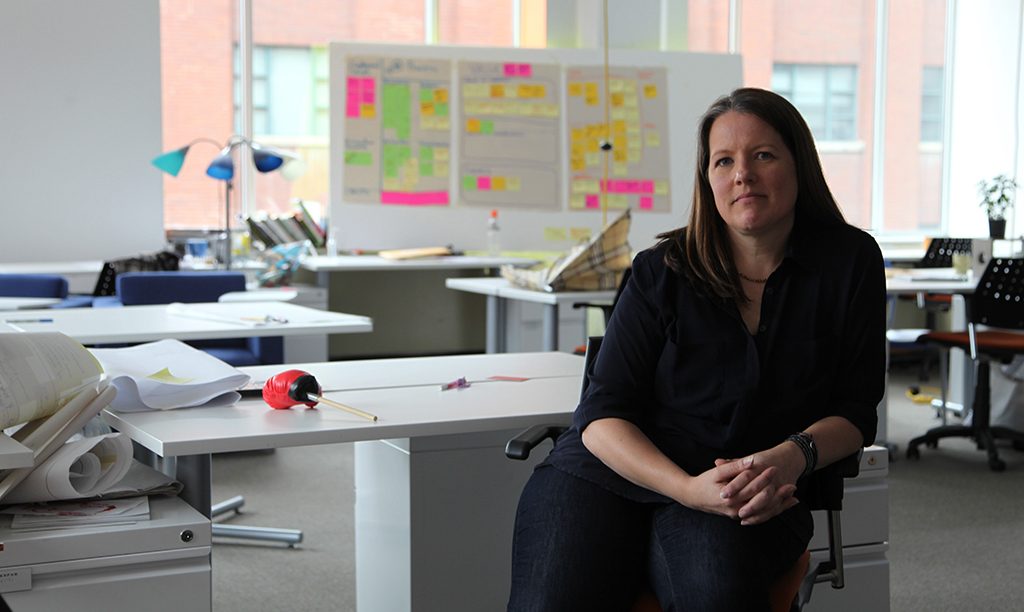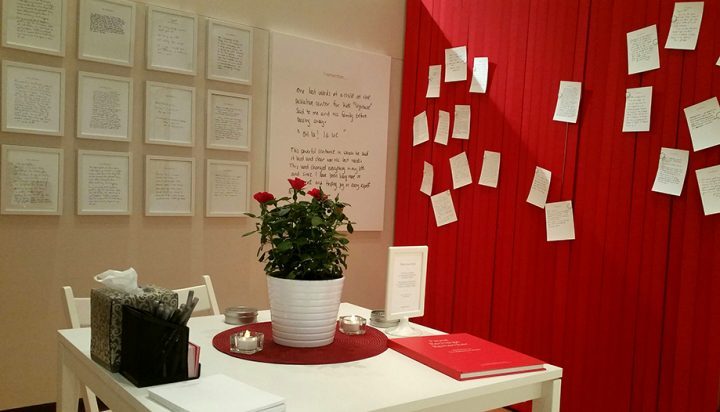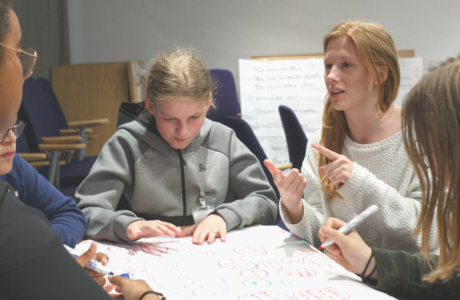A design-driven approach to innovation in health care, putting people at the centre and involving them in co-creating the future.
Human Centered Design to support patient centered care
The Moment is a purpose-driven organization. Our purpose is to join and amplify people who discover and shape thriving futures for all of us. We do this because of the ever evolving and accelerating changes in our world that are disrupting systems and structures. We do this by working in joined up teams with people in organizations who are working to create value for people that can be adopted at scale. The people of The Moment are driven to do not only good work, but meaningful work. At The Moment, we’re shaping what work and client projects look like in pursuit of our purpose. One space where we are growing with great intention toward our purpose is in health care.
There is no shortage of reasons for wanting to participate in service design challenges in the health care space. At the heart of it, the work is deeply meaningful and perhaps the greatest public policy and practice challenge of our time. Our population is aging and we are already feeling the added demands on our current system. Health care has an impact on people in some of the most vulnerable moments in their lives. And, poorly delivered health care services that have become outdated, ill-paced, or technically lagging have an even greater impact on the most vulnerable people in our society. Good service design in these contexts has immense potential to address small, large, and systemic health care challenges.
Service design does not and should not live in its own little bubble. Services are delivered to and by people, and thus are inherently part of large, complex systems. Thus, we need to take a systems approach to how we think about the delivery of health care. Other design firms have centred their health care efforts mainly around pharmaceutical service design, yet pharma is only one piece of the puzzle when it comes to the larger health care picture. We believe there is a wealth of challenges which have the potential for more impact that lie outside of the pharmaceutical delivery design practice.
Health care + service design
At The Moment, we are intentionally growing our team and our health care practice. Our approach to design-driven innovation in health care is focused on the high-touch health care spaces, and deals with the tough challenges faced by health care practitioners, patients, and family in those complex environments. Some of those challenges include infection control, reducing falls and/or pressure ulcers, improving the hospital discharge experience, and the experience of death and dying. Though our practice is focused on outcomes and experience of patients, families, and caregivers, we are also committed to improving the experience of health care workers, as we’ve seen the impact of their workplace well-being on the people they care for.
After 8 years of work in design-driven innovation in health care, I had the pleasure of co-authoring an article for Longwoods Healthcare Papers (December 2017). For an innovation designer, not a health care practitioner, the experience of having an article published and peer reviewed was inspiring and helpful in moving the discussion of what’s possible forward. I was particularly inspired by the feedback of Paul Plsek and his insights on discretionary time around clinical and best practices.
Because humans in a CAS [complex adaptive system] maintain some control over their discretionary effort, change advocates desiring sustainable change must work with stakeholders to co-create cases for change that resonate with the values of those being asked to change.
Contrary to the opinions of some who try to apply mechanistic assembly line approaches to health care delivery, we must always remember that at the heart of health care are people — the patients and the practitioners. People are, by nature, complex entities engaged in complex problems, and complex problems are rarely, if ever, solved through linear approaches. Because service design is not a user-centred practice but instead a human or people-centred practice, it takes into account not only the experience of the patient, but that of the practitioner as well. The experience of giving and receiving care involves not only physical actions and practices, but relational ones too. Often it is the patient and family experience of how they are treated, communicated to, and engaged in understanding what’s happening to them that are transformative and that leave a lasting impression on patients, even when their treatments or procedures are considered clinically successful.
Human-centered design for the future of health care
Never was this more apparent than when our Moment team worked with Hamilton Health Sciences (HHS) on building their 20 year strategy for the future. Our first engagement with them was a deep-dive discovery into the needs and values of the communities HHS serves. After meeting with hundreds of people and co-creating a shared understanding of what a desirable future might look like, we synthesized the information.
Five challenges emerged as top priorities to address for building a successful, forward-looking health care approach:
- Ensuring that patients enjoy a quality experience throughout their journey and at every transition point
- Reimagining the role of the health care team to include the patients and their family, caregiver, and others in the circle of care
- Ensuring that every patient has someone who is knowledgeable and supported to understand and advocate for the patient’s well-being
- Making it easier for patients and families to navigate the health care system
And possibly the most impactful challenge:
- Create a service model where no person feels invisible, inadequate, unheard, or undeserving of our care and respect
All of these challenges have benefitted from a design-driven approach to innovation, putting people at the centre and involving them in co-creating the future. Each of the challenges also, and possibly more importantly, are not about treatment, procedures, or best practices. The issues that benefit from changes in the way people behave in interactions with others — is in that discretionary time around clinical procedure. These challenges have highlighted the need for HHS, and many other similar institutions, to evaluate and address social and emotional structures that dictate the ways in which health care is currently delivered.

he time is now to tackle the immense challenges in health care. As part of our purpose, and as a result of our experience in the industry, we feel called to the challenge. Because of all these elements, and our growing health care practice, I am particularly excited about welcoming our newest Momenteer to the team: Karen Oikonen.
Karen has deep experience working on health care design challenges. Whereas I and my colleagues at The Moment have been working on designing solutions to on-unit problems and locally experienced patient challenges, Karen has begun to address issues that affect our society in the most vulnerable moments of our lives. Her human-centered design work on death and dying has produced remarkable insights and promising outcomes. In particular, she collaborated with Saint Elizabeth Health Care on creating The Reflection Room. This unique experience served as a catalyst for people across the country to begin talking about their experiences with death and dying — moving the topic from denial to discussion. Her research on the experience of death and dying at a distance addresses the very relevant realities of many Canadians who may not be geographically present for the death of a loved one. Her important work explores the tension between the medicalization of death and the family journeys through a person’s decline.

The Reflection Room is a design-led initiative that serves as a space for people to talk about experiences around death and dying
Innovation design specifically for health care
Non-healthcare designers often find it hard to gain access to health care delivery organizations because they are “not healthcare people”. This seriously limits these organizations’ collective ability to bring in design-led innovation. If a health care organization hasn’t yet experienced a design practice that can inform how practitioners shape the time around their clinical practices, it can be tediously difficult to find space for these new ways of sense-making. That being said, we are starting to see signals of greater interest and openness toward a using a design approach. For example, we recently engaged in design-led projects with both UHN Healthcare Human Factors and Saint Elizabeth Health Care.
Service design is a cross-disciplinary endeavour and it is extremely well suited for working with cross-functional health care teams, patients, families, and ourselves as practitioners. In my work, I have experienced the initial distrust in my abilities to design with clinical practitioners when I am not one myself. I have also experienced the shift in that mindset to one of appreciation for the “fresh eyes and perspective” that an outside design professional can offer — changing the conversations around what’s possible.
Knowing that health care environments have so much at risk when engaging in innovation work, we are sensitive to language and conventions of those spaces and to the unique challenges faced by people who have devoted their working life to the care of people. With that in mind, Karen and I are refreshing our Moment Culture Scan for use in health care contexts. We plan to make this freely available to any health care organization or professional who wishes to begin their journey into understanding how the culture of working in these environments affects practice and outcomes. If you would like to be first to get the scoop on the new Culture Scan for Health Care, get in touch.







